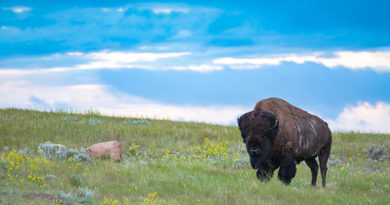NCC: Canada’s splendid sparrow crew
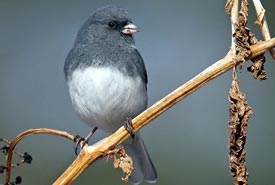
Dark-eyed junco (Photo by Bill Hubick)
Sparrows often don’t get enough credit. Many don’t have flashy plumage like jays, orioles or cardinals, or melodic songs like thrushes or meadowlarks; however, sparrow species are often fairly distinct (once you get to know them) and some of them are actually quite flashy too. In honour of World Sparrow Day (March 20), I thought I’d take some time to introduce some of Canada’s sparrows.
What is a sparrow?
The term “sparrow” refers to birds that are in the Passerellidae family and includes 47 different species in North America. Not all members of the North American sparrow family have sparrow in their name (such as juncos, towhees and some types of buntings). Adding to the confusion, sparrows exist in other parts of the world as well, but these species typically belong to taxonomic families that are different than North American sparrows.
House sparrows
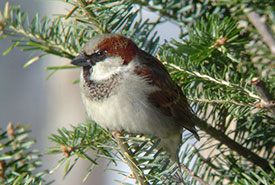
Male house sparrow (Photo by Roy LaPointe)
One of the most abundant and common songbirds in the world is the house sparrow. I am fairly confident that even if you don’t regularly observe birds, you have seen a house sparrow. As their name suggests, the species does well living near humans and is more commonly found near human habitations than in remote, wild places. House sparrows are not native to North America, and subsequently are not closely related to the sparrows found here. In fact, they are in a different taxonomic family: Passeridae.
Male house sparrows can be distinguished from females by the presence of a black bib extending from the throat down to the top of the breast, a black stripe between the bill and the eye, and chestnut colouring on the side of the head and wings. Females are brown and plain looking. The black bibs sported by male house sparrows play an important role in sorting out the pecking order within the flock — more dominant males have larger, darker bibs.
Now let’s meet some members of the sparrow family native to North America.
Harris’s sparrow
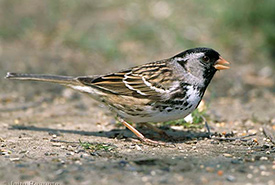
Harris’s sparrow (Photo by John Reaume)
Harris’s sparrow is one species that is truly Canadian. It breeds exclusively in northern Canada (from eastern Northwest Territories and western Nunavut into the northeastern corners of Saskatchewan and Manitoba). It is the only North American songbird with this claim to fame. The species breeds in semi-forested tundra and builds its nest on the ground using mosses, lichens and small twigs.
Harris’s sparrows are large sparrows with a distinctive black hood that covers their nape, crown and throat. They are otherwise brown and streaky, with a pink bill. Just like house sparrows, older, more dominant male Harris’s sparrows have a larger and darker bib than their younger, less dominant flock mates. Harris’s sparrows spend the winter in the south-central Great Plains and are most easily observed in the Prairie provinces during migration, where they are frequent backyard and feeder visitors.
Baird’s sparrow
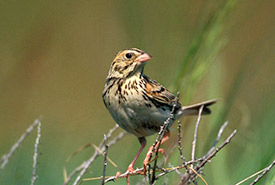
Baird’s sparrow (Photo by Alan MacKeigan)
Baird’s sparrows are one of the many little brown birds often seen on prairie grasslands. The species is rather non-descript: brown and streaked. Although their colour may be drab, the song of the Baird’s sparrow is distinct ― three short notes followed by a lower-pitched trill.
Like most grassland birds, Baird’s sparrow nests on the ground, and the nest is created using coarse grass and is lined with fine grass and other fibers. Here’s an interesting fact about Baird’s sparrows: when flushing from their nests, which is when they’ve been startled off their nest or out of cover, they don’t fly straight off the nest itself, like most other species. Instead they run a few metres on the ground before flying away. This strategy prevents predators from easily pinpointing the nest location based on where the bird flushed.
Song sparrow
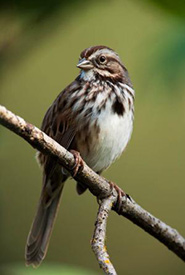
Song sparrow (Photo by Jim Dunn)
The song sparrow is one of the most widespread and diverse songbirds in North America and can be found in a variety of different habitats from coast to coast. You can find song sparrows in open habitat, like marsh or forest edges, backyards and overgrown fields. Song sparrows usually place their nest in shrubs and create it using grass, bark or other vegetation, lining it with finer material, such as grass, rootlets and animal hair.
Song sparrows are brown with heavy, bold streaking on their white breast and flanks; however, their appearance varies across their wide range, from small pale birds in the desert of the southwest U.S., to large, dark ones on the Aleutian Islands in Alaska.
Spotted and eastern towhees
Spotted and eastern towhees are the flashy, fashionista members of the sparrow family, and the two used to be considered the same species because of their similar appearance. Both towhee species have a black head and throat, back and wings, rust-coloured sides and a bright white breast. Spotted towhees are distinguished from eastern towhees by the bright white spots on their wings, which are lacking in eastern towhees.
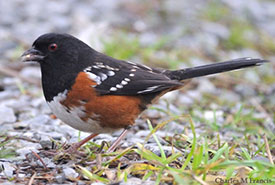
Spotted towhee (Photo by Charles Francis)
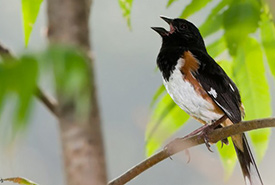
Eastern towhee (Photo by Kelly Colgan Azar)
The two species also differ in geographic range, only overlapping where their ranges meet in the Great Plains. Spotted towhees are a western species, and eastern towhees, as the name suggests, can be found in eastern North America.
Both towhees forage on the ground and can be found in shrubby habitat with dense leaf litter. Both species place their nest on or near the ground, building it with a framework of dried leaves, twigs and strips of bark and lining it with fine, dry materials, such as grass, rootlets and animal hair.
Sparrows occur in almost every habitat available on the landscape and are found all across North America. Hopefully this brief introduction to some of the members of the sparrow family has inspired you to go see which species can be observed in your area. I suspect you will find more than the ubiquitous house sparrow.



